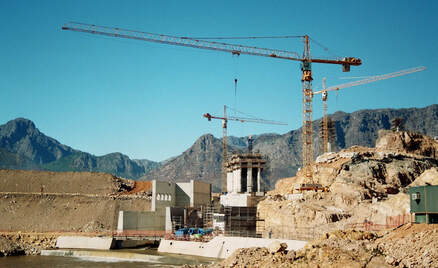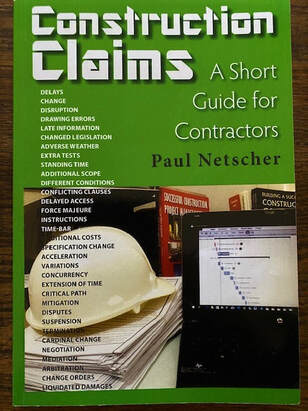"What is holding your construction project back?" Many construction projects are completed late. The reasons for this can be complex and depend on many factors. Often it’s the fault of the contractor and their poor project management. Late completion is costly to both the contractor and the customer. It also damages the contractor’s reputation. Planning the construction project properly before work starts and managing the project during construction is essential and goes a long way to avoiding delays. Equally important is to have a well-prepared construction schedule (construction programme) which considers the construction methodology and the known constraints. This schedule needs to be regularly updated and the results assessed to ensure the construction project is on-track to be completed on time. Mistakes that impact construction schedules/programmes. With this knowledge the project team can take timely action to rectify schedule slippage. If slippage isn’t corrected as soon as possible it invariably becomes worse, and the time remaining to catch-up the lost time becomes less, making it harder to make up the delay. It will eventually become impossible to catch up and finish on the due date. Unfortunately, many contractors don’t investigate why their construction project is falling behind and simply add more resources in an effort to catch-up. This is expensive and doesn’t always help. By the time they find out that more resources aren’t working, more time has slipped by and there’s less chance of catching up. "It’s often the case that the customer is causing delays which weren’t foreseen in the contract document. Why should the contractor then be responsible for these delays?" In a previous post I discussed some reasons why contractors cause themselves to fall behind schedule. (Read: 10 Reasons why your project is behind schedule.) Many of these reasons can be easily rectified. However, in some case it’s not the contractor’s fault, rather the customer or their team that’s causing delays to the construction. In some cases these delays should have been allowed for in the contract construction schedule as they were spelled out clearly in the contract document. However, it’s often the case that the customer is causing delays which weren’t foreseen in the contract document. Why should the contractor then be responsible for these delays? It’s important for the contractor to highlight these delays to the customer and the team so they can take steps to rectify the situation. Also, the contractor needs to submit an extension of time claim (delay claim) for these delays so that they aren’t penalised for finishing the construction project late when it’s not their fault. They also must recoup costs they have incurred due to the delays. 15 Rules for construction variation claims and change orders "There are many reasons to consider when analysing why the construction project is falling behind schedule." Is your customer, or their team, delaying your project?There are many reasons to consider when analysing why the construction project is falling behind schedule. We previously discussed reasons due to the contractor. Now let’s discuss the reasons customers delay the project: 1. The customer provides construction information late. I’m sure we’ve all been on projects where the client’s drawings have been issued late. This delays the project and frustrates the contractor’s team. If the customer has an agreed contract schedule they should know when the information is required so there’s no excuse. Providing an information schedule which links back to the construction schedule is a valuable aid. The customer often has to be regularly reminded of the forthcoming project information requirements. Immediately notify the customer (or their project manager) when information is late and where necessary lodge a delay or variation claim. An introduction to construction variation claims for construction project managers video 9 - What information and by when? 2. Late access. Often contractors are dependent on the customer providing access in accordance with the agreed construction schedule. The project will be delayed if these dates aren’t met and the contractor is entitled to claim for these delays. 3. Changes in specification. This is something that contractors don’t always detect until it’s too late. Change in specifications often increases the price of items, but they could also have longer manufacturing lead times. In some cases specifications are changed after items have been ordered which means that the original order has to be cancelled and new orders placed which can significantly delay projects. Sometimes customers and their designers aren’t aware of the implications to the project of these changes. If they are immediately made aware they may revert back to the original specifications to avoid delays and additional costs. 4. Scope increases. One mega project we were constructing was priced on a re-measurable bill of quantities. During construction our construction team was struggling to stay on schedule and was continually asking for more resources. Eventually we had much more equipment and people than we had allowed when we priced the project and consequently were showing major losses on our cost reports. When the team eventually caught up with re-measuring the quantities they found that some items had increased in quantity by more than 25%. Unbeknown to the construction team they had been accelerating the works at our cost – doing more work in the same period of time. Many projects increase in scope and contractors need to continually compare the actual scope with the scope they priced. Increased scope usually means we need more time to complete the project or additional resources to complete it in the original time. Contractors need to timeously notify their customer of scope increases as these usually add to the project cost which is detrimental to the customer’s budget as well as requiring additional time to complete. "Increased scope usually means we need more time to complete the project or additional resources to complete it in the original time." 5. The client’s activities cause delays. Sometimes the contract document includes customer activities and constraints that the contractor has to work around and accept. In these cases the contractor’s schedule should have taken account of them. However, often during the course of construction the customer introduces new constraints. On some projects we have had to shut down the work several times a week to allow our customer to carry out blasting activities. In other cases our work hours have been limited. Some existing facilities may have particularly rigorous security arrangements which impacts and delays the movement of people and materials onto the project. 6. Additional quality tests and inspections. Customer’s quality managers at times can introduce additional tests or quality inspections which are not only costly but can cause delays. Some clients add in additional ‘hold’ or inspection points or require 24 hour or even 48-hour notice periods for inspection. It’s important the customer is immediately notified so they can reassess these requirements to ensure the additional costs are worth the benefit. "Quality managers at times can introduce additional tests or quality inspections which are not only costly but can cause delays." 7. Late drawing or design approval. The project construction schedule and document should stipulate the maximum turn-around time to approve the contractor’s drawings and designs. Some customers aren’t good at keeping to these times. However, in some cases contractors cause further delays because their drawings aren’t correct, are not submitted through the correct channels or aren’t in the correct format. 8. The customer’s team doesn’t immediately respond to request for information and drawing queries. Unfortunately, I’m sure we’ve all received drawings with missing or conflicting information. On occasion querying and receiving the corrected information can be a tedious and time consuming process which delays the construction project. These delays need to be brought to the customer’s attention. We always include a list of all outstanding queries in our project meetings. 9. Customers’ not providing facilities and utilities in the required quantities and in the time they were obligated to supply them. On one of our earthmoving projects the customer undertook in the contract document to supply water at a specified point and in the quantities we required. Unfortunately the designated water point wasn’t ready until we were several months into the project. The alternative supply was 3 miles further away, it was used by other contractors and it couldn’t deliver the quantity of water we required every day. We not only needed more water tankers to haul the water a longer distance, but they had to queue behind other contractors to refill. As we know water is required for compaction so the limited water supply reduced the amount of material we could compact each day. This reduced our production which increased our costs and caused major delays. Ensure that the customer has provided the utilities and facilities where the contract says they should and that the quantities are in accordance with the agreed contract. 10. The customer’s other contractors impact and delay your work. They may restrict access to your work areas, damage your completed work or hold-up your work where you are required to interface with them. "Know when you can claim and what you can claim, then present the variation claim or change order with full information and backup documents." Ensuring your construction project is finished on timeBy being aware of the customer’s obligations in the contract document and the project construction schedule contractors can take active steps to ensure their customer fulfils them. Customers are quick to blame the contractor for delays to the project and fail to understand how their own actions are damaging progress. "Contractors often require to manage their clients and customers to ensure the construction project is completed on time." Don’t allow your customer to delay your construction project. Ensure you have an agreed project construction schedule which specifies information and access required dates. Regularly monitor construction progress and understand where and why delays are occurring and then take swift action to correct slippage. If it's your customers fault notify them and advise them of the consequences so they can rectify their problems. Contractors often require to manage their clients and customers to ensure the construction project is completed on time. An introduction to construction variation claims. Video 6 Reasons for extension of time claims To read more about the author’s books and find out where you can purchase them visit the pages on this website by clicking the links below:
'Successful Construction Project Management: The Practical Guide' 'Building a Successful Construction Company: The Practical Guide' 'Construction Book reviews' To read more about the author visit the page 'Paul Netscher' Want to contact Paul Netscher please enter your details on 'Contacts' Find out how Paul Netscher can help you Order your books from Amazon Order your books from Amazon UK © 2016 This article is not to be reproduced for commercial purposes without written permission from the author. construction management construction project management
6 Comments
Article was nice, It reminds me to remember things I know, but tend to forget during my busy day! Thanks! Now we are facing some problems in our projects like how to root causes of delay in infrastructure projects, our construction projects suffer from delay & disruption of work and loss of productivity, late
Reply
Paul
28/3/2017 09:28:09 am
Hello VJ, Primavera may help, as will many other similar planning systems. A good planning system is a tool, but you need someone who understands the system, and understands the project.
Reply
Nice Blog..Thanks for sharing..
Reply
Shaan
4/2/2018 11:59:45 am
Dear Paul,
Reply
paul
4/2/2018 03:25:06 pm
Hello Shaan, you will find my book, 'Construction Claims: A Short Guide for Contractors' useful as it provides invaluable advice on submitting variation claims.
Reply
beryltryphosa
15/11/2019 01:11:57 pm
https://www.wikitechy.com/online-videos/company-interview-questions-and-answers/snowflake-computing-interview-questions-and-answers-part1
Reply
Leave a Reply. |
Archives
June 2024
Note: We welcome genuine comments, especially comments that add additional information to the subject matter in the article. We however reserve the right to remove inappropriate comments, which includes comments that have nothing to do with the subject, comments that include inappropriate language, and comments that are an advertisement for a product or company, or which include an advertising link. Comments must be in English. We will not enter into discussion on why a particular comment was removed.
CategoriesCopyright 2016 - The attached articles cannot be reproduced for commercial purposes without the consent of the author.
The opinions expressed in the attached articles are those of the writer. It should be noted that projects are varied and different laws and restrictions apply which depend on the location of the contractor and the project. It's important that the reader uses the supplied information taking cognisance of their particular circumstances. The writer assumes no responsibility or liability for any loss of any kind arising from the reader using the information or advice contained herein. "I have what I consider some of the best books on construction management."
Books are available from: Amazon.com Amazon.co.uk takealot.com kalahari.com Amazon.in Amazon.de Amazon.fr Amazon.it Amazon.com.au Powell's Fishpond uread bokus Amazon.ca Amazon.es Other retail stores Available in paperback or on Kindle "28 YEARS OF CONSTRUCTION PROJECT MANAGEMENT EXPERIENCE, DEVELOPING SUCCESSFUL CONSTRUCTION PROJECT MANAGERS AND BUILDING SUCCESSFUL CONSTRUCTION COMPANIES"
|









 RSS Feed
RSS Feed




